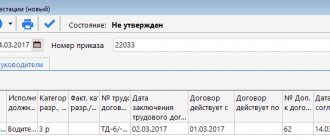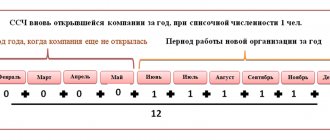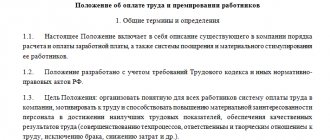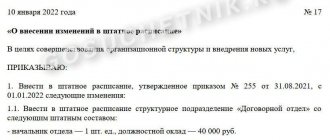“We must, boss, we must!”
How long ago did the company carry out certification of workplaces regarding working conditions?
This question may be asked both by the workers themselves and by inspectors from the labor inspectorate. For many employers it will be unexpected, since they have never heard of workplace certification. Article 209 of the Labor Code states that certification of workplaces according to working conditions is an assessment of working conditions at workplaces in order to identify harmful and (or) dangerous (special - Ed.) production factors and implement measures to bring working conditions into compliance with state regulatory requirements for labor protection.
Meanwhile, we are talking about one of the main responsibilities of the employer - to ensure safe conditions and labor protection (Article 212 of the Labor Code of the Russian Federation). And you need to take this seriously, so as not to incur an administrative fine from the labor inspectorate.
The main task of workplace certification is to create safe working conditions for employees. Of course, this will inevitably require certain financial costs, but they can subsequently be reimbursed with the help of the Social Insurance Fund at the expense of previously made deductions.
Of course, certification is carried out according to a certain procedure. Moreover: new rules will come into force in the very near future.
Certification of workplaces according to working conditions
From 1992 to 2013 inclusive, workplace certification was carried out according to working conditions.
FOR REFERENCE
The procedure for certification of workplaces for working conditions was approved by Order of the Ministry of Health and Social Development of Russia No. 342n dated April 26, 2011. Certification of workplaces for working conditions involved a comprehensive assessment of working conditions at workplaces in order to identify harmful and (or) dangerous production factors and implementation of measures to bring working conditions into compliance with state regulatory requirements for labor protection, identifying the degree of their harmfulness and danger to the employee. The regulatory framework for certification of workplaces based on working conditions was:
- labor code of the Russian Federation;
- regulatory legal acts containing state regulatory requirements for labor protection, as well as other documents on labor protection;
- systems of labor protection documents operating in certain types of economic activity.
The term “certified workplace” meant a workplace that has undergone a certification procedure for working conditions. At the same time, the assessment of working conditions could be different depending on the compliance or non-compliance of the actual values of factors of the working environment and the labor process with hygienic standards, compliance or non-compliance with the requirements for injury safety of the workplace and the provision of workers with personal protective equipment. In general, certification of workplaces for working conditions included:
- hygienic assessment of working conditions and nature (instrumental measurements and assessment of physical and chemical factors: illumination, noise, vibration, microclimate, non-ionizing radiation, chemical composition of the air in the working area);
- assessment of psychophysiological factors of the labor process (severity and intensity of the labor process);
- expert assessment of workplace injury safety;
- assessment of the provision of workers with special clothing, special footwear and other personal protective equipment (PPE) in accordance with established standards.
The results of workplace certification for working conditions were used for the following purposes:
- providing employees hired with reliable information about working conditions in the workplace, about the existing risk of damage to health;
- justification of benefits and compensation to employees for working in difficult, harmful or dangerous working conditions;
- justification of labor restrictions for certain categories of workers;
- justification for planning and financing measures to improve labor conditions and safety in organizations, including through funds for compulsory social insurance against industrial accidents and occupational diseases;
- justification for providing employees with free certified special clothing, special shoes and other personal protective equipment, as well as flushing and neutralizing agents in accordance with established standards;
- resolving the issue of the connection between the disease and the profession if an occupational disease is suspected;
- calculation of discounts and allowances to the insurance rate in the system of compulsory social insurance of workers against industrial accidents and occupational diseases (the discount can reach up to 40% of the insurance rate).
The certification process began with the selection of a certification commission formed from employees of the organization who had been trained in general issues of workplace certification. Certifying commission.
All workplaces available in the organization were subject to workplace certification. The validity period of the results is the same as for the special assessment: 5 years from the date of the first instrumental measurements of harmful and dangerous production factors. Documents on certification of workplaces for working conditions were recommended to be kept in the organization for 45 years.
The following workplaces were subject to mandatory re-certification of workplaces according to working conditions (re-certification):
- after replacing production equipment;
- changes in the technological process, collective protective equipment, etc.
If, as a result of measurements carried out under the production control program for compliance with sanitary rules, critical changes in the levels of labor process factors are detected, then the data obtained are subject to evaluation, as well as consideration of the need to make changes to workplace certification cards. Newly organized workplaces were certified after they were put into operation.
The results of workplace certification for working conditions were compiled in the form of a package of documents containing:
- an order to conduct certification of workplaces based on working conditions and to involve the Certifying Organization in this work (if necessary);
- a list of workplaces of the organization that are subject to certification of workplaces according to working conditions, highlighting similar workplaces and indicating the assessed factors of working conditions;
- copies of documents for the right to carry out measurements and assessments of working conditions by the Certifying Organization;
- workplace certification cards for working conditions with protocols of measurements and assessments of working conditions;
- statements of workplaces (WM) of departments and the results of their certification of workplaces for working conditions and a consolidated statement of workplaces of the organization and the results of their certification for working conditions;
- action plan to improve and improve working conditions in the organization;
- minutes of the meeting of the certification commission based on the results of certification of workplaces for working conditions;
- order to complete certification of workplaces and approve its results (performed by the certified organization).
After certification of workplaces for working conditions, the employer sends a list of workplaces, statements of workplaces of the organization’s divisions and the results of their certification for working conditions and a consolidated statement of workplaces of the organization and the results of their certification for working conditions to the state labor inspectorate in the constituent entity of the Russian Federation.
Costs for certification of workplaces based on working conditions could be reimbursed. The Social Insurance Fund could also partially reimburse the institution's costs for certification and improving working conditions for workers. Thus, according to the Decree of the Government of the Russian Federation of November 19, 2007 N 787 “On financing in 2008 and in the planning period 2009-2010 preventive measures to reduce industrial injuries and occupational diseases of workers and sanatorium-resort treatment of workers engaged in work with hazardous and (or) hazardous production factors" The Ministry of Health and Social Development has developed Financing Rules approved by Order No. 43n dated January 30, 2008.
According to clause 2 of the Financing Rules, financing from the amounts of insurance contributions for compulsory social insurance against accidents at work and occupational diseases is also subject to the costs of certification of workplaces for working conditions.
Financing of preventive measures was carried out by the policyholder in accordance with the amounts of insurance premiums subject to transfer to the Social Insurance Fund in the current calendar year. The amount of funds allocated by the policyholder to finance preventive measures could not exceed 20 percent of the amounts of insurance premiums accrued for the previous calendar year, minus the costs of paying security for the specified type of insurance, made by the policyholder in the previous calendar year.
To receive compensation, the institution had to submit to the FSS department before August 1:
- a plan for financing preventive measures to reduce injuries and occupational diseases;
- action plan to improve working conditions and safety;
- a copy of the report on the results of the inspection by the state labor inspectorate, which should contain recommendations to certify workplaces and (or) reduce the level of dust and air pollution;
- a copy of the agreement with an accredited organization for work on certification of workplaces;
- calculation of the cost of work;
- a copy of the accreditation certificate with the scope of accreditation;
- copies of documents based on the results of workplace certification;
- copies of documents confirming the purchase of equipment, work to reduce the level of dust and air pollution in workplaces;
- documents from an accredited organization on the results of repeated measurements of dust and gas contamination.
Compensation was paid within the limits of allocations allocated by the Social Insurance Fund to regional funds.
It was necessary to take into account that financing of certification of workplaces for working conditions and certification of work on labor protection could be carried out at the expense of (20%) insurance contributions for compulsory social insurance against industrial accidents and occupational diseases. In addition, an organization that certified workplaces for working conditions could count on receiving a discount on the insurance rate for compulsory social insurance against accidents and occupational diseases (necessary grounds).
Based on the results of the work, it was possible to justify:
- Benefits and compensations due to employees for harmful working conditions;
- Additional leave and reduced working hours;
- Additional payments for hazardous working conditions;
- Dispensing milk or other equivalent products;
- Preferential pension provision.
A new certification procedure is on the horizon
On April 26, 2011, the Ministry of Health and Social Development of Russia, by order No. 342n, approved a new Procedure for certification of workplaces based on working conditions (hereinafter referred to as Order No. 342n; Certification Procedure). This means that the previous certification rules, which were in effect for exactly three years (approved by order No. 569 of August 31, 2007), will soon cease to apply.
Let's name specific dates: the new rules for workplace certification will come into force on September 1, 2011. Accordingly, the old procedure will cease to be valid from the same date and will no longer apply.
Let us also clarify that the Certification Procedure is mandatory for all organizations. The only exceptions are employers - individuals who are not individual entrepreneurs.
Additional Information
Certification of workplaces according to working conditions
Why is labor protection poor at construction sites? Or why is it necessary to certify workplaces based on working conditions? Certification of workplaces based on working conditions is a set of measures carried out to assess working conditions in workplaces, identify harmful and dangerous production factors, and also bring working conditions into compliance with the established requirements of legislative acts of the Russian Federation. . On September 1, 2011, a new Procedure for certifying workplaces based on working conditions came into force. In accordance with the new law, from September 1, 2013, companies located in the Russian Federation that have not passed certification (recertification) of workplaces will be subject to penalties up to and including suspension of the company's activities.
Workplace safety
Safety in the workplace must be provided to the employee by the management of the organization. This is one of the requirements of the labor legislation of the Russian Federation, and all violations in this area are strictly controlled and severely punished. In order to ensure a safe workplace, it is necessary to conduct regular and timely assessments of it, these measures will help ensure not only appropriate conditions for the individual, but also help create a safe working environment for the entire organization. Modern organization of the labor process and safety in the workplace contributes to a positive impact on the overall productivity and efficiency of work for each employee. In this situation, it is necessary to constantly comply with all rules and safety standards in the workplace.
Requirements for a computerized workstation
Before starting work on certification of computerized workplaces for working conditions, each specialist is required to attend courses, take part in seminars or trainings. This training is necessary to ensure that the inspector clearly understands what the workplace certification procedure requires and what these requirements are. During the training, the specialist will be able to become familiar with the main differences between the existing and new certification procedures and learn practical recommendations for developing an assessment of materials that must analyze all the requirements for the workplace. First of all, the courses are intended for employees who hold leadership positions in an expert organization and offer professional occupational safety services. The procedure for carrying out certification has a rigid structure, which practically does not depend on the area of operation of the enterprise. A group of accredited specialists conducting the certification procedure checks the compliance of workplaces with safety regulations, their technological equipment and rationalization. Experts carry out a hygienic assessment of activities and working conditions, analyze the traumatic safety of workplaces, and the level of provision of workers with personal protective equipment. As a result of the certification, identified deficiencies are analyzed, conclusions are formulated, on the basis of which a plan is developed to improve working conditions. Certification of workplaces is a detailed analysis, which is especially important when there is complex technical equipment in production that poses a potential threat to the life and health of personnel. The protocol on working conditions, drawn up by specialists based on the results of the automated workplace, is supplemented by the following applications: Certification map. Job statements, certification results. General list of the company's workplaces, results of their certification. Scheme of an action plan aimed at improving working conditions at the enterprise.
Cost of workplace certification
Calculation of the cost of certification is individual for each enterprise, since the price is formed depending on the factors to be assessed.
Instruments and equipment during certification of workplaces
| Our measuring instruments | |
| Name | Make, model, year of manufacture |
| Meteorological parameters meter | "EcoTerma-01", 2012 |
| Non-selective radiometer | "Argus-03", 2012 |
| Digital electromagnetic field converter | P3-80-EN500, 2012 |
| Electric and magnetic field strength meter P3-80, with digital converter P3-80-E | 2012 |
| Three-component electric and magnetic field parameters meter | BE-meter-AT-003, 2013 |
| Electrical socket status indicator | ISER-01, 2012 |
| Sound level meter-vibrometer, spectrum analyzer | "Ecophysics-110A", 2012 |
| Set Ecoacoustics-110A, | |
| Adapter kit for installing 3-component vibration sensors | 110-KIT-MA3 |
| Gas analyzer | "Kolion-1B", 2012 |
| Luxmeter-pulsemeter-brightness meter | "Ecolight-01" with additional photo head FG-1, 2012 |
| UV radiometer with attenuation filter | "TKA-PKM" (model 13), 2012 |
| Dosimeter-radiometer | MKS-AT1117M with detection unit BDPS-02 (gamma, X-ray, alpha, beta radiation), 2012. |
| Low-flow aspirator for air sampling | "BREEZ-2"., 2012 |
| Rotameter with local readings, type RM, | 2012 |
| Gas analyzer GANK-4S Ex with explosion protection marking | 2Ex(ib)dIIBT4., 2012 |
| Gas analyzer | "Kolion-1B", 2012 |
| Measuring tape | EX10/5, 2012 |
| Electronic pedometer-ergometer | "SHEE-01", 2012 |
| Stopwatch | SOSpr-2b-2-000, 2012 |
| Dynamometer | DS-500, 2012 |
| Protractor with vernier | 4UM, 2012 |
About the author Mikhail Markov
SOUT expert
You might be interested in
other services
Directive 2006/42/EC "Machinery and mechanisms"
Ensuring fire safety of buildings and structures
SDS Military Register
Explosion safety technical data sheet
Validity period: five years
Order No. 342n specifically notes that the results of workplace certification carried out before September 1 according to the current rules are in full force after September 1, 2011, but before the next certification, namely, the approval of its results.
Let us remind you: according to the general rule (which has not changed), certification must be carried out every five years. In this case, the start date of the next certification is considered to be the date the employer issues an order approving the composition of the certification commission and the certification schedule. This provision contains only the new Certification Procedure.
The procedure for certification of employees
From Art. 81 of the Labor Code of the Russian Federation it follows that the procedure for conducting certification activities is established both by labor legislation and other regulatory legal acts, as well as local acts of the organization. Since the general procedure for certification is not established at the legislative level, each enterprise prescribes its own rules in the appropriate regulation.
When developing regulations on the certification procedure, enterprises should familiarize themselves with the standards prescribed, for example, in the Decree of the State Committee for Science and Technology of the USSR, Gosstroy and Goskomtrud dated February 17, 1986 No. 38/20/50, which is still in force.
The norms of this resolution are allowed to be applied to the extent that does not contradict the Labor Code of the Russian Federation. In practice, they can be taken into account by the courts when considering disputes about the reinstatement of workers dismissed based on the results of an attestation audit.
You can find the certification regulations in the ConsultantPlus forms. Don't have access? Sign up for a free trial of K+.
For reference, you can use the provisions of the Decree of the State Committee for Science and Technology of the USSR and the State Committee for Labor dated 05.10.1973 No. 470/267, a source regularly used by personnel services until its abolition on 02.12.2020 by Decree of the Government of Russia dated 16.11.2020 No. 1850. On its basis, a fairly extensive judicial system was formed practice. Thus, in the ruling of the Moscow City Court dated September 10, 2015 No. 4g/8-7875-2015, with reference to Resolution No. 470/267, it is indicated that the regulatory act on certification approved at the enterprise worsened the situation of workers due to non-compliance with the norms of regulations from the times of the USSR.
Briefly, the certification procedure can be divided into the following stages:
- Approval of the certification regulations.
For information about what this document is, read the material “Regulations on the certification of employees - sample.”
- Preparation for certification, which includes:
- approval of the composition of the certification commission;
- establishment of categories of certified employees;
- approval of the schedule for certification inspections;
- preparation of documents for certified employees;
- bringing to the attention of employees information about the date and place of certification.
NOTE! At this stage, an appropriate order is issued, which provides the above information. The information contained in this order and all possible annexes to it (for example, on the inspection schedule) is communicated to the certified employees against signature.
- Carrying out certification.
- Recording the results and making a decision by the manager based on the results of certification in relation to each employee.
A detailed step-by-step algorithm of actions during certification is explained in the Ready-made solution from ConsultantPlus. You can familiarize yourself with the rules by getting free access to the system.
Off plan
In the new certification rules, several norms are devoted to unscheduled certification (in the previous ones they were absent). According to them, it is necessary to begin certifying newly organized workplaces no later than 60 working days after their commissioning (clause 8 of order No. 342n).
It is noteworthy that this is not the only case when unscheduled certification is necessary. The rest are listed in section VI of the order (replacement of equipment, change in production technology, etc.).
As with the planned certification, the main result of the unscheduled certification is the compiled workplace certification cards and other documents.
New approach
Order No. 342n more competently reflected today's realities and features of the labor process.
For example, when talking about the composition of the certification commission in small business organizations and micro-enterprises, legislators did not forget about an external labor protection specialist, who (one or more) may be part of it (clause 10).
And paragraphs 41 and 42 of Order No. 342n stipulate the features of certification of non-stationary jobs, as well as when a position or profession involves (at the suggestion of the employer) the performance of functions unusual for it.
The approach to terminology has also changed significantly: if now workplaces are assessed from the point of view of injury safety, then from September 1 of this year - in terms of injury risk.
It is extremely important that now the employer will be involved in organizing and ensuring the certification, and not directly conducting it and assessing jobs. This is already the prerogative of a specialized organization accredited by the Ministry of Economic Development, with which the employer enters into a civil contract. By its legal nature, this is, as a rule, a mixed agreement with elements of contracting and paid services. The certifying organization itself determines its work methods, as well as the quantitative and personal composition of specialists conducting measurements and assessments.
Important
Certification of workplaces should not be confused with certification of workers for professional suitability or suitability for the position held.
You need to start building relationships with a specialized research and testing center (laboratory, institute) by requesting a certificate and notification of its inclusion in the register of organizations providing services in the field of labor protection. If necessary, several such organizations can be involved in certification.
Thus, the new Certification Procedure was approved to form an institution for an independent and professional assessment of working conditions at each workplace. This is the position of the Ministry of Health and Social Development.
Certification of employees according to the Labor Code of the Russian Federation is mandatory
In accordance with the Labor Code of the Russian Federation, certification of employees for compliance with the position held is mandatory for researchers (Article 336.1 of the Labor Code of the Russian Federation) and teachers (Article 332 of the Labor Code of the Russian Federation).
At the same time, scientific employees must undergo certification at least once every 5 years and no more than once every 2 years. The frequency of certification checks for teachers is once every 5 years. In addition to these cases prescribed in the Labor Code of the Russian Federation, certification is provided for in some industry regulations to regulate the procedure for conducting activities (most often unsafe).
Thus, the following are required to undergo certification:
- employees called upon to ensure transport security (Article 12.1 of the Law “On Transport Security” dated 02/09/2007 No. 16-FZ);
- state civil servants (Article 48 of the Law “On the State Civil Service of the Russian Federation” dated July 27, 2004 No. 79-FZ);
- workers responsible for loading/unloading, placing, securing cargo on railway transport and work related to the movement and maneuvering of trains (Clause 4, Article 25 of the Law “On Railway Transport in the Russian Federation” dated January 10, 2003 No. 17-FZ);
- workers engaged in the field of industrial safety (Part 2 of Article 9 of the Law “On Industrial Safety of Hazardous Production Facilities” dated July 21, 1997 No. 116-FZ);
- persons heading federal unitary enterprises (Resolution of the Government of the Russian Federation “On the procedure for concluding employment contracts and certification of managers...” dated March 16, 2000 No. 234) - once every 3 years;
- other categories of workers specifically specified in laws and industry regulations (for example, firefighters, rescuers, prosecutors, aviators, etc.).
The procedure for conducting certification may be regulated by acts that are not normative in nature. For example, employees of cultural and art institutions undergo certification in accordance with the letter of the Ministry of Culture of Russia dated 02/08/2010 No. 7790-44/04-ПХ. Clause 2.1 of this document states that the frequency of certification is determined by the institution independently (taking into account the time periods during which the knowledge and skills necessary to carry out activities become obsolete) and that, on average, certification is carried out once every 3–5 years.
Often, employers use certification to check the qualifications of employees for the purpose of their subsequent dismissal. So, in paragraph 3 of part 1 of Art. 81 of the Labor Code of the Russian Federation indicates the possibility of dismissal of employees by the employer due to their poor certification results.
You will find more information about dismissals initiated by employers in the article “Procedure for dismissing an employee at the initiative of the employer.”
At the same time, certification is an opportunity to reward an employee for achievements in the workplace or to promote him up the career ladder. In addition, based on the results of the qualification test, a decision may be made to send an employee for training.
Based on the results of certification, medical workers receive qualification categories and differentiated wages. The right to certification to achieve these goals is established in subsection. 4 paragraphs 1 art. 72 Federal Law “On the fundamentals of protecting the health of citizens in the Russian Federation” dated November 21, 2011 No. 323-FZ.
You will learn more about the certification of medical workers from our article.
At the same time, there are categories of employees who cannot be dismissed at the initiative of the employer, even with poor certification results. This:
- pregnant women;
- single mothers;
- mothers with young children under 3 years old, etc.
Their rights are protected by Art. 261 Labor Code of the Russian Federation. In order to somehow resolve the situation, the employer must find a socially protected employee who has not passed the certification another job with lower qualification requirements.
Read more about the dismissal of an employee who has not passed certification in the ready-made solution “ConsultantPlus”. You will receive even more useful information if you sign up for a free trial access to K+.
Sometimes the employer is still inclined to terminate the employment contract with an inappropriate employee. But this can only be done by agreement of the parties or the desire of the employee himself. For example, termination of an employment contract is possible if it is impossible to change the employee’s type of activity for medical reasons due to the employer’s lack of suitable work (such conditions for termination of the contract are mentioned in Part 3 of Article 261 of the Labor Code of the Russian Federation).
What changed
There are almost no fundamental changes in the certification procedure in Order No. 342n. It was only spelled out more specifically and supplemented with new provisions. We list the main ones:
1) the composition of the certification commission has been clarified (in addition to representatives of the employer, occupational safety specialist, and representatives of the certifying organization, it must include a representative of the elected body of the primary trade union organization or another representative body of workers);
2) responsibilities for organizing and conducting certification are more clearly distributed between the employer, the certification commission and the certifying organization. Thus, certification is carried out (i.e. directly evaluates jobs) by the certifying organization. But in any case, the certification commission is headed by a representative of the employer;
3) innovation affecting the rights of employees: if during certification harmful or other special factors affecting the health of personnel are identified, this guarantees (!) that employees will receive certain benefits established by the Labor Code;
4) The deadlines within which the certification results must be issued are established:
a) 10 calendar days - for the certification commission to consider the certification report and to transfer it along with the minutes of the meeting to the employer (his representative);
b) 10 working days - to sign the order to complete the certification and approve the report, as well as to familiarize employees with the results of certification of their workplaces against signature;
c) 10 calendar days - to send a summary statement of certification results, as well as information about the certifying organization to the labor inspectorate.
Moscow still recommends
Despite the existence of an approved all-Russian Certification Procedure, regional authorities are not completely eliminated from this issue within their territory.
A case in point is Moscow. Here, by order of the vice-mayor dated June 23, 2004 No. 10-RVM, Recommendations for conducting certification of workplaces for working conditions in organizations of the city of Moscow were approved. Although the document is relatively old and based on no longer valid decrees of the Russian Ministry of Labor, it continues to operate and is generally still relevant. In addition, it contains several forms of documents: certification order, certification card, assessment protocols, job sheets, etc.
Transition period: from certification to special assessment
In accordance with the new document, some provisions of the acts that relate to the procedure for paying contributions to compulsory pension and social insurance have been changed. Among the amendments there are those affecting the formation of budgets of the Pension Fund and the Social Insurance Fund of the Russian Federation and the expenditure of corresponding funds, and those directly affecting employers.
Now all organizations are required to conduct a special assessment of working conditions, the results of which will make it clear what rate of additional tariff they should apply, established by Article 58.3 of Federal Law No. 212-FZ.
Personnel officers have a lot of work to do, related not only to assessing working conditions, but also to reporting to the Pension Fund according to the new RSV-1 form. Now, to reflect the contribution for additional tariffs in the RSV-1 form, there are as many as three subsections. Regarding filling out subsections 2.2 and 2.3, HR officers could figure it out last year, when they applied an undifferentiated additional tariff that was not related to the assessment of working conditions and certification. The new form now includes subsection 2.4, which HR officers fill out if they apply tariffs depending on the certification of workplaces for working conditions carried out before January 1, 2014. Its results are valid for five years, but no longer than until December 31, 2022. Those organizations whose certification period has expired must conduct a special assessment of working conditions in accordance with Federal Law No. 426-FZ.
The Russian Ministry of Labor clarified that it is not necessary to conduct a special assessment of working conditions immediately. The demand of certain officials of state supervisory bodies for employers to immediately conduct a special assessment of working conditions or immediate certification of workplaces is not justified. The results of workplace certification for working conditions are valid for five years from the date of its completion, but no more than until December 31, 2022. These results can be used by employers for the purposes established by Federal Law No. 426-FZ of December 28, 2013, with the exception of exemption from paying insurance contributions to the Pension Fund of the Russian Federation at an additional tariff.
And now a transition period has begun (attestation is no longer used, and few people have managed to conduct a special assessment). Since Federal Law No. 426-FZ recently came into force, personnel officers are having difficulty filling out the calculation. Particularly many questions arise from those organizations where some workplaces have been certified, and for others a special assessment of working conditions has been carried out. Or it happens that neither certification nor special assessment has been carried out.
The Russian Pension Fund recommends using the following table to determine the procedure for paying insurance premiums at additional rates (see table).
Along with this “cheat sheet,” we recommend that you remember a number of points that will allow you to avoid mistakes when determining the additional tariff and filling out the RSV-1 form.
- The condition for the application of the additional tariff of insurance premiums is the employee’s employment in the jobs specified in paragraphs 1 and 2-18 of subparagraph 1 of Article 27 of Law No. 173-FZ. Therefore, the calculation of insurance premiums at an additional tariff in favor of an employee engaged in work with harmful, dangerous and difficult conditions is carried out regardless of whether this period is included in the length of service or not.
- Payers of insurance premiums who have not passed the certification of workplaces for working conditions and a special assessment of working conditions as of January 1, 2014, pay insurance premiums at the rates provided for in parts 1 and 2 of Art. 58.3 of Law No. 212-FZ, parts 1 and 2 of Article 33.2 of Law No. 167-FZ, namely: 6% - in relation to payments and other remuneration in favor of individuals engaged in the types of work specified in subparagraph 1 of paragraph 1 of Art. 27 of Law No. 173-FZ, and 4% - in relation to payments and other remuneration in favor of individuals engaged in the types of work specified in subparagraphs 2-18 of paragraph 1 of Article 27 of Law No. 173-FZ. Such payers fill out subsections 2.2 and 2.3 in RSV-1; in section 6, they do not indicate a code for a special assessment of working conditions.
- Payers of insurance premiums who have undergone a special assessment of working conditions pay insurance premiums at additional rates established by Part 2.1 of Article 58.3 of Law No. 212-FZ and Part 2.1 of Article 33.2 of Law No. 167-FZ: using a differentiated tariff of insurance premiums. This group of payers fills out subsection 2.4 in RSV-1, and in section 6 indicates the code for a special assessment of working conditions. If, based on the results of a special assessment of working conditions, a class of working conditions is assessed as optimal or acceptable, in other words, recognized as safe, then the payer is exempt from paying insurance premiums at additional rates.
- Payers of insurance premiums who have passed workplace certification as of January 1, 2014 and have the corresponding document - a certification card, in which working conditions are defined as dangerous or harmful, indicating the subclasses of working conditions, calculate insurance premiums at additional rates in accordance with Part 2.1 of Article 58.3 Law No. 212-FZ and part 2.1 of Article 33.2 of Law No. 167-FZ. They fill out subsection 2.4 in RSV-1, and in section 6 indicate the code for the special assessment of working conditions.
- If, based on the results of certification, working conditions are recognized as optimal or acceptable, then the payer is not exempt from paying insurance premiums at additional rates until a special assessment of working conditions is carried out. And calculates insurance premiums at a rate of 6% in relation to payments and other remuneration in favor of individuals employed in the types of work specified in subparagraph 1 of paragraph 1 of Art. 27 of Law No. 173-FZ, and 4% - in relation to payments and other remuneration in favor of individuals engaged in the types of work specified in subparagraphs 2-18 of paragraph 1 of Article 27 of Law No. 173-FZ. This type of payer fills out subsections 2.2 and 2.3 in RSV-1; in section 6 the code for a special assessment of working conditions is not indicated.
In addition, personnel officers must fill out the length of service for each insured person, indicating codes of special working conditions or codes of grounds for early assignment of a pension (only if contributions have been paid at additional tariffs). Since 2014, the classifier of parameters used when filling out personalized information has been supplemented with new codes in the part “Calculation of insurance experience: additional information” (see table).
| Class of working conditions | Subclass of working conditions | Code (in section 6) |
| Dangerous | 4 | O4 |
| Harmful | 3.4 | B3.4 |
| 3.3 | B3.3 | |
| 3.2 | B3.2 | |
| 3.1 | B3.1 |
They can be used when filling out information about the length of service to highlight any periods that should be included in the length of service; individual codes are included in the length of service.
And finally, changes regarding the conduct of a special assessment of working conditions were made not only to pension legislation - the Code of Administrative Offenses of the Russian Federation was also supplemented with new norms, namely Article 5.27.1, according to which an employer can be fined for violating the procedure for conducting a special assessment of working conditions for workers places or its failure. The fine for officials and individual entrepreneurs will be from 5,000 to 10,000 rubles, and for legal entities - from 60,000 to 80,000 rubles. The changes made to the Code of Administrative Offenses of the Russian Federation will take effect on January 1, 2015.
Try the Kontur-Personal program for free
About responsibility
The issue of employer responsibility for labor protection is perhaps the most important. Let us immediately draw your attention to the fact that workplace certification is entirely included in this category. These are violations such as:
1) failure to certify workplaces;
2) violation of frequency;
3) failure to comply with the certification procedure approved by the Ministry of Health and Social Development.
The advantage for the employer of the new Certification Procedure is that it clearly delineates the responsibilities of the employer and the certifying organization (clause 52 of Order No. 342n); The rules that are still in effect do not really say anything about liability.
Responsibility is divided as follows: the employer is responsible for conducting certification, the accuracy and completeness of providing information to the labor inspectorate, and the employer and the certifying organization are responsible for the accuracy of measurements and assessments. Why does the employer appear in the latter case? But because it directly depends on him how complete and accurate the package of documents that he will present to the certifying organization will be so that it can assess the workplace.
Keep in mind: the certification center may refuse to conduct certification if you do not provide the documents it needs.
Fine and trial
There is not a word in the Code of Administrative Offenses about certification of workplaces based on working conditions. But legal and judicial practice has developed in such a way that violations in this area fall under Article 5.27 “Violation of labor and labor protection legislation.”
This article provides for the following administrative penalties: a fine for officials from 1000 to 5000 rubles; from individual entrepreneurs - from 1000 to 5000 rubles or suspension of activities for up to 90 days; from legal entities - from 30,000 to 50,000 rubles or similar suspension of activities.
There are examples in judicial practice when parties try to resolve a dispute related to workplace certification in arbitration court. However, this is not true. So, for example, in the resolution of the Federal Antimonopoly Service of the East Siberian District dated March 9, 2006 No. A74-72/06-F02-942/06-S1 in case No. A74-72/06 and the resolution dated August 26, 2010 in the case No. A10-591/2010 explicitly states that disputes regarding workplace certification are heard by courts of general jurisdiction.
Who is subject to certification and who conducts it?
Certification, depending on the area of activity of the organization, can be mandatory, legally established, or can be carried out on the initiative of the administration and employees.
the results of employee certification for compliance with the position held summed up and documented ?
Mandatory certification is regulated by an extensive package of regulatory and legislative acts of federal and industry significance: Labor Code of the Russian Federation, Art. 332, 336.1 (regulates issues of mandatory certification of scientific and teaching workers), Federal Law-16 dated 9/02/07 “On Transport Security”, Federal Law-79 dated 27/07/04 “On State Civil Service”, Letter Ministry of Culture 7790-44/04-ПХ dated 08/02/10 and a number of others.
Question: Is it possible, as part of dismissal due to incompatibility with the position held, of an employee with whom a permanent contract has been concluded, to be transferred with his consent to a seasonal vacancy by concluding a fixed-term employment contract? View answer
Thus, the following categories of workers undergo mandatory certification:
- civil government employees;
- health workers;
- teachers;
- workers in the field of science;
- prosecutors;
- firefighters;
- rescuers;
- transport workers (pilots, railway workers, persons ensuring transport safety);
- heads of unitary enterprises of federal significance;
- specialists in the field of industrial safety;
- related to the movement and securing of cargo;
- cultural workers;
- other categories of workers, in accordance with federal and industry standards.
For commercial organizations and individual entrepreneurs, certification is not required, but can be specified in the LNA and used to determine the qualification level of employees.
Question: An employee, upon dismissal for inadequacy of her position, did not report her pregnancy. Is the employer obligated to reinstate her? If so, what to do with unsatisfactory certification results? View answer
The non-obligatory criterion applies only if the company is not associated with activities for which certification is mandatory. For example, if an entrepreneur carries out activities related to securing and moving cargo or an organization carries out auxiliary work in the field of railway transportation, their employees must undergo certification.
When developing LNA and carrying out the procedure, it is recommended to be guided by the following documents:
- Resolution No. 470-267 dated 5/10/73 (a joint document of the State Committee for Science and Technology and the State Committee for Labor).
- Resolution No. 38-20-50 of 02/17/86 (a joint document of the State Committee for Science and Technology, Gosstroy and the State Committee for Labor).
They were adopted during the existence of the USSR, however, when considering labor disputes related to the results of certification, courts often refer to their provisions.






